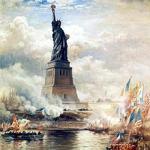 In Rome’s Piazza Mignanelli, just southwest of the Piazza di Spagna, stands the Column of the Immaculate Conception. On Sunday, December 8, continuing a tradition of Popes since 1857, Pope Francis visited the Column to pray and to lay a wreath of roses before the bronze statue of the Virgin Mary.
In Rome’s Piazza Mignanelli, just southwest of the Piazza di Spagna, stands the Column of the Immaculate Conception. On Sunday, December 8, continuing a tradition of Popes since 1857, Pope Francis visited the Column to pray and to lay a wreath of roses before the bronze statue of the Virgin Mary.
Vatican Radio reports:
The celebration began with a reading from the book of Revelation in which Mary is described as a “woman, clothed with the sun, with the moon beneath her feet, and around her head a crown of twelve stars” (Rev. 12:1). The Holy Father then recited a prayer to the Immaculate Conception, in which he asked Our Lady to “awaken in us a renewed desire for holiness,” and to “make present all of the Gospel’s beauty” in our lives.
He went on to ask Mary’s intercession in helping us remain attentive to the Lord’s voice, and to never be indifferent to the cry of the poor, the sick, the elderly, of children, and every human life. Before taking leave of the Piazza, the Holy Father greeted the sick and disabled who had gathered in the Square for the celebrations.
* * * * *
Here is the story of that column, and of the beautiful statue which stands there.
The Column
Crafted of Cipollino marble, the Column of the Immaculate Conception stands almost 39 feet tall. It’s a Corinthian column and was crafted in ancient Rome. In the year 1777, during construction of the nearby Monastery of Santa Maria della Concezione, the column was rediscovered and erected in its current location, in front of the offices of the Palazzo di Propaganda Fide (offices for promulgating the faith), now renamed the Congregation for the Evangelization of Peoples, and near the Spanish Embassy to the Holy See.
The Statue
The statue of the Immaculate Conception was carved by the Italian neoclassical sculptor Giuseppe Obici. It depicts the Virgin Mary standing on a crescent atop the world, stomping a serpent—a symbol of the dogma that Mary, the spotless woman chosen by God to bear the Christ Child, was conceived without original sin. The statue was consecrated by Pope Pius IX on December 8, 1857, three years after the promulgation of the papal bull Ineffabilis Deus which proclaimed that Mary had, indeed, been sinless from the time of her conception.
Standing the monument in its place was a challenge in 1857—so more than 200 local firefighters aided in its erection. Since that time, the firemen of Rome have continued to help in a ceremony each year—climbing a ladder on a fire truck to place a wreath around the right arm of the Virgin Mary.
 The Four Hebrew Figures
The Four Hebrew Figures
At the base of the Column of the Immaculate Conception are four statues of Hebrew figures from Scripture: David, Isaiah, Ezekiel and Moses. Each of the figures gave portent of the virgin birth; and the statues each have carved in their bases a biblical verse in Latin which foretells Mary’s sinlessness.
DAVID. Beneath the statue of David (sculpted by Adam Tadolini) is carved Psalm 45:5 “…the Holy Place where the Most High dwells.”
This refers to the fact that God preserved the Virgin Mary from original sin in view of the Incarnation of her Son through her. In this way, God sanctified her who would be a worthy dwelling for His Son. Mary became the living resting place of God. In her the Lord dwelt, in her the Lord found His place of rest.
ISAIAH. Beneath Isaiah (carved by Salvatore Revelli) is Isaiah 7:14 “Therefore the Lord himself will give you this sign: the virgin shall be with child, and bear a son, and shall name him Immanuel.”
The Fathers of the Church understood this verse to refer to the Virgin Mary and her Virgin birth. Jesus was born of Mary, who remained ever Virgin before, during and after the birth as she was not touched by original sin.
EZEKIEL. Ezekiel’s statue (sculpted by Carlo Chelli) bears an inscription referring to Ezekiel 44:2 “that the exalted dignity of the Mother of God, her spotless innocence and her sanctity unstained by any fault.”
The Fathers of the Church taught that this verse also refers to Mary’s immaculate conception.
MOSES. Finally, the statue of Moses (created by Italian sculptor Ignazio Jacometti) bears a scripture from Genesis 3:15 “I will put enmity between you and the woman”.
It was this verse to which the Apostolic Constitution Ineffabilis Deus referred when it said:
…The Fathers and ecclesial writers taught that with this divine prophecy “the merciful Redeemer of mankind, Jesus Christ, the only begotten Son of God, was clearly foretold: That his most Blessed Mother, the Virgin Mary, was prophetically indicated; and, at the same time, the very enmity of both against the evil one was significantly expressed. Hence, just as Christ, the Mediator between God and man, assumed human nature, blotted the handwriting of the decree that stood against us, and fastened it triumphantly to the cross, so the most holy Virgin, united with him by a most intimate and indissoluble bond, was, with him and through him, eternally at enmity with the evil serpent, and most completely triumphed over him, and thus crushed his head with her immaculate foot.”
Around the column’s base and between the four statues, bas reliefs depict four events: the Annunciation, St. Joseph’s dream, the Coronation of Mary as Queen of Heaven, and the definition of the dogma of the Immaculate Conception.










